"OUR GOAL IS JERUSALEM" — MILITANT ISLAMISTS IN SOUTHEAST EUROPE
by Gordon N. Bardos
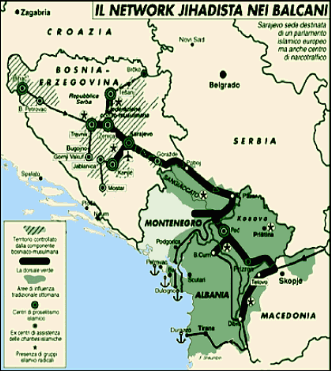
Over the past several years, the Balkans has emerged as a new battleground for militant Islamism. [i] In June 2010, Islamist extremists bombed a police station in the central Bosnian town of Bugojno, killing one police officer and wounding six others. In February 2011, a Kosovo radical killed two US servicemen at Frankfurt Airport. In October 2011, a Sandzak Wahhabi attacked the US Embassy in Sarajevo. In April 2012, suspected Islamist extremists murdered five Macedonian citizens outside Skopje. In July 2012, Hezbollah operatives bombed a bus full of Israeli tourists in Burgas, Bulgaria. In March 2013, a Hezbollah operative was discovered monitoring Israeli citizens in Cyprus. [ii] In the first six months of 2012 alone, some 200 Iranian "businessmen" entered Bosnia, including an individual Israeli intelligence has tracked in Georgia, India, and Thailand—all countries in which terrorist attacks have targeted Israeli officials over the past two years.[iii]
As concerns grow that European and even American jihad volunteers in Syria could pose new security threats if and when they return to their home countries,[iv] large numbers of individuals from the Balkans have joined the Syrian jihad. According to one estimate, Bosnia has provided more Syrian jihad volunteers than any other country in Europe per capita,[v] with several hundred citizens of Bosnia & Herzegovina now reported to be fighting in Syria,[vi] along with a large number of Bosnian émigrés.[vii] It has also been reported that Bosnia and Romania are sources of weapons for the Syrian jihad, as the arrest of a Swedish imam-turned arms-procurer, Haythan Rahmeh, revealed.[viii] In addition, reports suggest up to 140 ethnic Albanians are now fighting alongside Islamist groups in Syria,[ix] as well as and some thirty individuals from the Sandzak.[x] Priština media have reported that some 30 individuals from Kosovo went to Syria in January 2014 alone, and that six Albanians have already died in the fighting there.[xi] In an interesting example of comparative rates of radicalization, one observer has noted that more individuals from the Balkans have joined the Syrian jihad than from Central Asia or the Caucasus.[xii] An indication of the degree to which the threat of violent Balkan extremists joining the Syrian jihad has become, and the danger they pose to their native states and societies upon their eventual return, is the January 2014 dispatch of a large, multiagency US government delegation (including individuals from the FBI, the NSA, the Department of State, and the Department of Justice) on a fact-finding mission to the region.[xiii]
The Balkan blowback from the Syrian jihad is already being felt. In November 2013, six suspected terrorists (two of whom are believed to have fought in Syria) were arrested in Kosovo on suspicion of plotting terrorist attacks using cell-phone activated explosive devices. The group was also believed to have been involved in an attack on two American Mormon missionaries in Priština on November 3rd.[xiv] Subsequently, a group called "Xhemati i Xhehadit" warned police of "painful attacks" if their comrades were not released. The warning noted that "without doubt, we have people who love death more than you life in this world."[xv] The continuing threat from militant Islamist groups in the region was further on evidence in Bosnia, when at the beginning of the month the largest illegal arms cache discovered in postwar Bosnia was found near the central Bosnian town of Tešanj, in the heart of territory where foreign mujahedin and their local Bosnian allies operate. The weapons, which arrived in the area about 1999, included over five hundred 84mm grenades for rocket-propelled grenade launchers. Local authorities believed the weapons could have been used for terrorist attacks or provided for use on other jihad fronts.[xvi]
These have not been unexpected attacks and developments. Already in May 2007, a leading American observer of Islam in the Balkans had noted that "a visitor to Bosnia-Herzegovina, Albania, Kosovo, and Macedonia encountered unmistakable evidence that extremist intruders are opening a Balkan front in the global jihad,"[xvii] and in January 2010 Israeli officials warned that the Balkan region "is global jihad's next destination for creating an infrastructure and recruiting activists."[xviii]
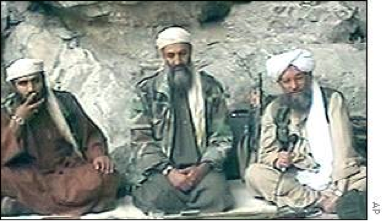
Indeed, almost every major terrorist action against the US and other western countries and interests over the past two decades has had Balkan ties or connections—including the 9/11 attacks, the August 1998 US African embassy bombings, the December 1999 Millenium Bomb Plot targeting Los Angeles' LAX Airport, the October 2000 attack on the USS Cole in Aden Harbor, the November 2003 Istanbul bombings, the March 2004 Madrid Train bombings, the 7/7 London Underground bombing, the May 2007 Fort Dix bomb plot, the July 2009 Raleigh Group conspiracy, and the January 2010 conspiracy to attack the New York subway system. The late Richard Holbrooke made clear the dangerous extent to which militant Islamism has infiltrated southeastern Europe when he noted that had it not been for the Dayton Peace Accords, "al-Qaeda would probably have planned the Sept. 11 attacks from Bosnia, not Afghanistan."[xix]
Balkan Jihadi Threat Matrix
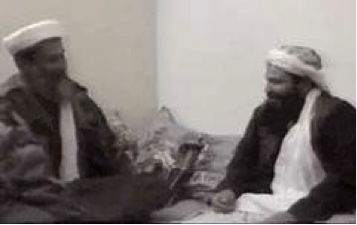

"Without Dayton, al-Qaeda would probably have planned the Sept. 11 attacks from Bosnia, not Afghanistan." — Richard Holbrooke
Making these attacks possible is the sophisticated infrastructure Balkan Islamist militants have created over the past two decades. The infrastructure consists of four main components: 1) local allies in political, security, and religious establishments; 2) safe havens consisting of radical-controlled mosques and remote villages which provide militant Islamists places to recruit, organize, train and hide; 3) NGO's and financial institutions providing terrorists with cover identities and the ability to clandestinely transfer operational funds; and 4) various electronic and print media promoting their extremist ideology. Such complex, multi-faceted organization allows militant Islamist groups to sustain the occasional crackdown or arrest without substantial damage to their networks or infrastructure as a whole.[xx]
Local Allies
The origins of militant Islamism's rise in the Balkans can be traced to the life and work of Bosnia's late Islamist president, Alija Izetbegović. In the late 1930s/early 1940s, Izetbegović and a conspiratorial group of like-minded Islamist extremists formed an organization called the Mladi Muslimani ("Young Muslims") whose goal, in Izetbegović's own words, was the creation of a "great Muslim state." [xxi] Towards this goal, the Mladi Muslimani established an underground journal with the telling title Mudžahid ("Holy Warrior") and swore an oath asking Allah to grant them perseverance in their "path of jihad" and their "uncompromisingly struggle against everything non-Islamic."[xxii] Several decades later, Izetbegović continued to promote this view; in his seminal work, the Islamska Deklaracija ("Islamic Declaration") Izetbegović would argue that "There is no peace or co-existence between Islamic faith and non-Islamic social and political institutions . . . the Islamic movement can and may move to take power once it is morally and numerically strong enough, not only to destroy the existing non-Islamic government, but to build a new Islamic government.[xxiii]
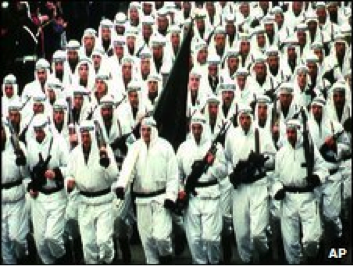
Given the existence of such local Balkan allies and sympathizers, it proved easy for Al-Qaeda and other Islamist extremist groups to extend their reach throughout Europe. After the Soviets withdrew from Afghanistan in 1989, Bosnia, according to one study, became "[a] new refuge, close to both the heart of Europe and the Middle East . . . an excellent tactical base for espionage, fundraising, and terrorist activities . . . a major center for terrorist recruitment and fundraising. . . a place where recruits could train, coalesce into cells, and seek shelter from prosecution by foreign law enforcement."[xxiv] The former NATO commander in Bosnia, US Army Major General Virgil Packett, has claimed that "Bosnia has moved from being a sanctuary for terrorism to a gateway for terrorism."[xxv] Other analyses further support this view, suggesting that the existence of an extensive network of individuals sympathetic to militant Islamism makes Bosnia a command and control center for various groups of regional militants.[xxvi] Estimates of the number of non-indigenous mujahedin who moved to Bosnia in the 1990s range from several hundred to six thousand.[xxvii]
Increasing the threat and capacity of militant Islamists in the Balkans is the support and cooperation they receive from local authorities sympathetic to their cause. In February 1996, NATO forces raided an Iranian-operated terrorist training camp in Bosnia where they found plans to NATO installations, booby-trapped children's toys, and essays on how to assassinate political opponents and critical journalists. The camp's director was the personal intelligence advisor to Bosnia's late Islamist president, Alija Izetbegović.[xxviii] His son, Bakir Izetbegović (currently a member of the Bosnian state presidency) has admitted to personally being in touch with leading mujahedin figures in Bosnia such as Imad al-Husin, a.k.a Abu Hamza, and offering "to help in any way."[xxix]
Like father, like son?
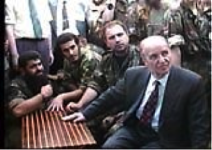
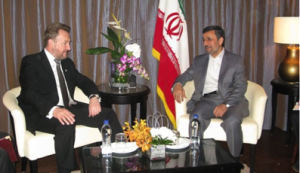
Local allies also provide international jihadists with new identities allowing them to travel and conduct operations around the world. A secret report prepared for the Clinton Administration in late 2000 "shocked everyone" when the scale in which the Izetbegović regime had provided travel documents to international extremists was revealed.[xxx] By one count the Izetbegović regime distributed some 12,000 Bosnian passports to international jihadis.[xxxi] Osama Bin Laden himself was the owner of a Bosnian passport,[xxxii] and Western reporters even saw him Izetbegović's office during the war.[xxxiii] When Italian police discovered a plot to kill Pope John Paul II in Bologna in 1997, all fourteen men arrested were travelling on passports issued by Izetbegović's foreign ministry.[xxxiv] (In April earlier in the year, another attempt to assassinate the Pope had been made in Sarajevo.)[xxxv] In the 1990s, Al Qaeda operative Safet Abid Catovic was given cover as a diplomat at Bosnia's Mission to the UN in New York.[xxxvi] In 1998, just days before the bombing of the US embassies in Dar es Salaam and Nairobi, Mamdouh Mahmud Salim, the mastermind of the attacks, visited Bosnia on a "business trip" on a visa issued to him by the Bosnian consulate in Ankara.[xxxvii] In September 1999, Turkish police arrested Mahrez Auduni (at the time considered one of bin-Laden's top aides) traveling on a Bosnian passport (Number 0801888).[xxxviii] As of January 2014, the chairman of the security committee in Izetbegović's Islamist party is a man on the US government's Specially Designated Nationals and Blocked Persons List, and who is otherwise widely considered to be the leading Iranian agent in Bosnia.[xxxix]
Balkan Bases
In remote, isolated villages around the Balkans militant Islamists have developed a network of extra-territorial, sharia-run enclaves that serve as recruiting stations for local converts and safe havens for jihadis from around the world. In Islamist-run villages such as the central Bosnian town of Bočinja Donja, extremists live "separate lives untroubled by local police, tax-collectors or any other authorities. Outsiders never set foot in the small community."[xl] Bulgaria's former chief mufti, Nedim Gendzhev, claims that extremists are trying to create a "fundamentalist triangle" formed by Bosnia, Macedonia and Bulgaria's Western Rhodope mountains.[xli]
The above-mentioned central Bosnian village of Bočinja Donja, inhabited by some 600 people, has been associated with numerous international terrorists, including Karim Said Atmani, the document forger for the Millenium Bomb plot; Khalil Deek, arrested in December 1999 for his involvement in a plot to blow up Jordanian tourist sites; and Omar Saeed Sheikh, involved in the murder/beheading of Wall Street Journal reporter Daniel Pearl.[xlii] Al Qaeda's second-in-command, Ayman al Zawahiri, is known to have visited the village in 1997[xliii] and spent much of the 1990s in nearby Bulgaria.
Another Bosnian village, Gornja Maoča, is the headquarters of Bosnia's main Wahhabi leader, Nusret Imamović. In 2005, Italian investigators discovered a Gornja Maoča-based plot to attack the funeral of Pope John Paul II and assassinate the assembled world leaders.[xliv] A former member of the Wahhabi movement from Gornja Maoča gave a detailed description of life in the village to a journalist, reporting that residents claims to personally know the editor of Inspire (Al Qaeda's online publication), and that members of the community who know Arabic regularly inform members about news and information from Al Qaeda websites. The village is frequently used as a way station for extremists joining jihads in Chechnya, Afghanistan, and Yemen. The Gornja Maoča community prefers to send unattached young men to jihad so that it does not have to assume financial responsibility for their families. The Wahhabis are also known to cache weapons in local forests surrounding the village.[xlv] In October 2011, the Sandžak Wahhabi Mevlid Jašarević left the village with two other residents on the day he attacked the US Embassy in Sarajevo.[xlvi] Another Wahhabi outpost in Bosnia is Bužim (near Bihać) in northwestern Bosnia, home to a prominent anti-American Wahhabi preacher, Bilal Bosnić, known for his YouTube spots supporting suicide bombings, glorifying the Taliban, and various anti-Semitic rants.
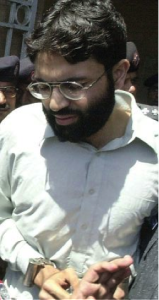
Bosnian jihad veteran Omar Ahmed Saeed Sheik, participant in the murder/beheading of Wall Street Journal reporter Daniel Pearl
In these remote Islamist-controlled areas, under the guise of "youth camps," former mujahedin take young people into the local hills and forests where they are given military training. The camps are intentionally non-permanent to make it more difficult for security officials to track them, but are effective in fostering the relationships needed for creating extremist networks.[xlvii] In March 2007, Serbian police raided one such camp in the mountainous Sandžak region straddling the border between Serbia and Montenegro, arresting a number of individuals and seizing weapons, explosives, and food stocks.[xlviii] The group was allegedly planning to attack western embassies in Belgrade. Similarly, in July 2013, a raid near the village of Kalošević, close to the the central Bosnian town of Tešanj, uncovered the largest stash of undeclared weaponry and explosives found since the end of the Bosnian war, including over 500 rocket propelled grenades. Local inhabitants of the village claimed the arms and ammunition were hidden there on the order of a high-ranking member of Izetbegović's party Bosnian media cite as one of the main local liaisons with Al Qaeda operatives in the country.[xlix]
Throughout the western and southern Balkans, extremist-led mosques also provide valuable bases for militant Islamists. A focal point for Wahhabi extremists in Bosnia is the Saudi-funded King Fahd Mosque and Cultural Center in Sarajevo, "the epicenter of the spreading of radical ideas" in Bosnia,[l] which for a number of years functioned autonomously under the direct supervision of the Saudi embassy in Bosnia. The White Mosque in Sarajevo is the headquarters of Sulejman Bugari, a Kosovo Albanian-born imam whom some reports have described as a go-between and point-of-contact for Albanian and Bosnian extremists.[li] In Kosovo, the Makowitz mosque on the outskirts of Priština and the Mitrovica mosque are reportedly recruiting militants to fight alongside Islamist groups in Syria.[lii] In Macedonia, Wahhabi extremists have been trying to take control of Skopje's Jahys Pasha, Sultan Murat, Hudaverdi and Kjosekadi mosques.[liii]
NGOs and Financial Institutions
Militant Islamists support their efforts in southeastern Europe through a network of "NGO's," "charities" and "humanitarian aid" organizations, funded by known Al Qaeda financial donors. The CIA has estimated that one third of the Bosnian NGO's operating worldwide have terrorist connections or employ people with terrorist links,[liv] and various NGO's with known ties to Al Qaeda funneled several hundreds of millions of dollars to Izetbegović's war effort.[lv] Izetbegović himself was on the Iranian payroll, receiving on just one occasion in $500,000 (US) in cash from Iranian agents.[lvi]
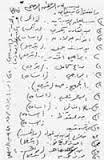
al Qaeda's donors' list, "The Golden Chain," discovered in Sarajevo in March 2002
In one example of how this was done, U.S.-based "charities" with close ties to Osama Bin Laden, such as Care International, Inc., received checks with memo lines such as "Bosnia mujahedin," "for jihad only," and "Chechen Muslim fighters."[lvii] Of the estimated $800 million the Saudis alone gave to Bosnia after Dayton, some $100 million is untraceable, lost in a maze of Al Qaeda front organizations funding terror activities worldwide.[lviii] In the aftermath of 9/11, a raid on the Saudi High Commission for Aid to Bosnia netted "maps of Washington, material for making false State Department identity cards and anti-American manuals designed for children."[lix] (the Saudi High Commission for Aid to Bosnia has been named as a defendant in a lawsuit brought by 9/11 victims and families in U.S. federal court.) Also found in Sarajevo in March 2002 was Al Qaeda's donor's list, the so-called "Golden Chain." Bin Laden's organization apparently felt so comfortable in Bosnia at this time that some seventy Al Qaeda members reportedly planned to flee there from Afghanistan in the wake of 9/11.[lx] Among the Al Qaeda-linked organizations working in the Balkans have been the Benevolence International Foundation (which had offices and personnel in Chicago), the "Taibah Foundation," the "Global Relief Foundation," which operated in Bosnia and Kosovo, and al Haramain, which was active in Albania.[lxi] The Turkish-based IHH (the "Foundation for Human Rights and Freedoms and Humanitarian Relief," or Insani Yardim Vakfi in Turkish) which was involved in the Mavi Marmara incident off the Israeli coast in May 2010, began its activities in Bosnia in the 1990s. In June 2010, Turkish authorities began an investigation of the group's founder, Bűlent Yildirim, for funding Al Qaeda.[lxii]
The lack of transparency in many Middle-Eastern-based banking institutions makes it extremely difficult to track the flow of monies to militant groups in the region.[lxiii] Monies donated for legitimate charitable purposes often get siphoned off and used to support weapons purchases or to provide support for families of imprisoned or killed jihadis. Members of the Al Qaeda cell in Albania, for instance, working under the cover of various Middle-East based charities, were required to contribute 26 percent of their salaries to support the global jihad; one such individual claimed that he diverted $800 per month (from funds intended for Albanian orphans) for such purposes. Monies provided from such sources have also financed political asylum applications in western countries, helping militants establish terrorist cells in Europe and the US.[lxiv] By 2010, the Albanian government had seized and confiscated some $7.5 million (USD) in assets from two individuals and thirteen foundations believed implicated in terrorist finance.[lxv]
The archetype for the way in which Islamist extremist organizations in the Balkans function was the Third World Relief Agency (TWRA), run by Elfatih Hassanein, a Sudanese national with known ties to Bin Laden. By some accounts, TWRA alone collected $400 million (US) for Izetbegović's war effort.[lxvi] TWRA, among other things, has been revealed to have provided some of the operational funding for the first group of World Trade Center bombers in 1993. [lxvii] Most of Izetbegović's inner circle was involved in the organization.[lxviii] Islamist NGO's and humanitarian groups also finance sending school-age children to study in countries such as Egypt, Libya, Saudi Arabia and Syria where they are indoctrinated in extreme forms of Islam.[lxix]
Militant Media and Propaganda
Militant Islamists in the Balkans have developed an extensive array of print periodicals, websites, and YouTube spots spreading religious intolerance, glorifications of violence, and anti-American, anti-Semitic, anti-democratic messages. Websites such as the "Way of the Believer" (putvjernika.com), Way of Islam" (stazomislama.com), Ensarije Serijata ("Partisans of Sharia" http://www.geocities.ws/ensarije_seriata/index-2.html), and "News of the Community" (vijestiummeta.com), and the Sandžak Wahhabi website kelimetul-haqq.org promote jihad, suicide bombings, and the killing of non-Muslims.[lxx] These websites also relay news from other jihadi fronts, sermons by extremist preachers from the Middle-East, and messages from Al Qaeda leaders; for instance, the Put vjernika website recently carried "A New Order from Zawahiri: Focus on Attacks on American Interests."[lxxi] According to Fahrudin Kladicanin, the co-author of a recent study on Balkan extremists' use of the internet and social media, "The number of those who are 'liking,' making comments and sharing the content of these pages, especially when it comes to religious leaders, extreme Islamists and Wahhabists, is rising on a daily basis." The Facebook profiles of almost all such extremist leaders have over 5,000 "friends" and even more "likes."[lxxii] The Facebook page Krenaria Islame (Albanian for "Islamic Pride"), which posts pictures and stories of Albanians fighting in Syria, has 2,500 followers. According to the Tirana-based security expert Arjan Dyrmishi, "If all the followers of this page were identified as terrorists, they would make a small army and pose a major problem. Such a large number of followers would a pose a concern, even if these people were to be identified only as supporters of political Islam."[lxxiii]
The US State Department has reported that the Bosnia-based "Active Islamic Youth" (Bosnian acronym AIO) spreads extremist views and has links with radical groups in Western Europe and the US.[lxxiv] Former members of the AIO publish a weekly called SAFF in both print and an online electronic version which the State Department has described as anti-American and tending towards extremism. Middle Eastern funders have established some 25 madrasas (Islamic religious schools) in Bosnia through which some 2000 students have already passed.[lxxv] In Kosovo, a radical preacher, Zahir Naik, has established a 12-hour daily Albanian-language, hardline-Wahhabi TV channel ironically called "Peace TV" which "which insults, in aggressive terms, spiritual Sufis, Shia Muslims, non-fundamentalist Sunnis, Jews, Christians, and Hindus, among others." In his sermons Naik has praised Osama bin Laden and supported terrorism.[lxxvi] Similarly, in Bulgaria, dozens of new mosques and Wahhabi "teaching centers" funded by Middle Eastern donors were opened over the past twenty years. In 2003, the Bulgarian government shut down a number of Wahhabi outposts because of their ties to the Muslim Brotherhood and other extremist groups. [lxxvii] Bulgarian security analysts have estimated that some 3000 youths have passed through these Wahhabi-funded educational centers over the past twenty years.[lxxviii]
Together with the large number of locally-born Islamic clerics who have studied in the Middle-East (including individuals such as Nedžad Balkan, Bilal Bosnić, Mustafa Cerić, Nusret Imamović), the combination of this large cadre of the indigenous population being educated in Middle-Eastern funded institutions in the Balkans themselves carries with it the potential danger of transforming what has usually been considered a "moderate Balkan Islam" into something more radical. As Esad Hećimović, a leading expert on the jihadi movement in Bosnia has noted, "There is now a new generation of Islamic preachers in Bosnia who were educated after the war at Islamic universities in Saudi Arabia, Jordan, Syria, and other countries . . . Thus, it is no longer possible to distinguish between 'imported' and 'local' versions of Islam in Bosnia and Herzegovina anymore."[lxxix]
Conclusion
Relatively small numbers of people in southeastern Europe subscribe to the extremist movements and ideologies represented by militant Islamism. A survey conducted in Bosnia in 2007 found that three percent of the population adhered to Wahhabism (perhaps some 50-60,000 people), out of an estimated Muslim population of approximately two million, and another ten percent identified with it.[lxxx] Current and former Bosnian Wahhabis, however, claim that the movement has many secret adherents. The above-mentioned Ikanović, for instance, has said that some forty percent of those adhering to the Wahhabi movement do not have the outward appearance of being Wahhabis.[lxxxi] Other former Bosnian Wahhabis have claimed that Wahhabi sympathizers have "infiltrated schools, universities, and the media."[lxxxii] In 2010, a Bosnian security official estimated that there are 3000 potential terrorists in Bosnia,[lxxxiii] and a former Al Qaeda operative in Bosnia, the Bahraini-born Ali Hamad, has claimed there are some 800 individuals of local origin making up a "white Al Qaeda": i.e., people who can pass through security checks avoiding racial profiling.[lxxxiv] In the immediate aftermath of the 9/11 attacks, NATO officials suggested there was a "hardcore group" of some thirty individuals in Bosnia with direct links to international terrorism.[lxxxv] In Kosovo, security experts suggest about 50,000 people adhere to the more conservative, Middle-Eastern forms of Islam,[lxxxvi] and one specialist on Balkan Islam has claimed that, "Exponents of Saudi-financed Wahhabism and of the Muslim Brotherhood have penetrated the highest levels of the official Kosovo Islamic apparatus."[lxxxvii] In Macedonia, the mufti of Skopje, Ibrahim Šabani, has estimated that there are some 500-600 Wahhabis in the country, possibly more,[lxxxviii] while other security specialists believe up to 3000 Wahhabis are active in Macedonia, mainly concentrated in areas around Skopje, Tetovo, Struga, and Kumanovo.[lxxxix] In the Sandžak, the International Crisis Group has estimated there are some 300 Wahhabis who control several mosques in the region,[xc] and some local analysts have claimed that the leader of the Islamic Community in Sandžak, Muamer Zukorlić, has close ties to the movement and receives funds from Wahhabi sources in Rome and Vienna.[xci]
Despite these relatively small numbers, however, the danger militant Islamists in the Balkans pose to US and Western interests, or to the creation of the tolerant, multiethnic, western-oriented democracies we desire in the region, is clear. The recent upsurge in extremist activity in southeastern Europe provides significant evidence to show that militant Islamism's Balkan front requires increased attention. Remarkably, western officials prefer to deny that any problem exists; for instance, the current High Representative in Bosnia, Valentin Inzko, claims that the Wahhabis in Bosnia are not a threat to Europe.[xcii] Militant Balkan Islamists, for their part, are not hiding their long-term intentions. As a Bosnian jihadi fighting in Syria recently noted, "I left Bosnia with the intention only to return with weapons in my hand. I am a part of the revolution and this is the morning of Islam . . . [by allowing us to leave Bosnia] your intelligence agencies made a mistake thinking that they would be rid of us, however, the problem for them will be the return of individuals trained for war."[xciii]
Moreover, it is a grave mistake to believe that it is only of tangential importance or interest that so many individuals who were involved in various terrorist actions around the world have travelled through the Balkans, because during their time spent in the region they developed numerous connections with like-minded extremists, sowing the seeds for new generations of extremists that threaten Balkan stability, and indeed US and western security interests around the globe. To again quote Esad Hećimović "Radical Islamic groups are waiting for a resurrection of the violent conflict . . . It is still conceivable that Islamic leaders and groups are waiting for a new jihad."[xciv] With the possible return of hundreds of Balkan extremists from the Syrian jihad, the same could become true for other parts of the Balkans as well.
END NOTES
[i] "Islamism" is here defined as a doctrine calling for the imposition of Islamic laws and precepts on the state and society at large. "Miliant Islamists" refers to those individuals who advocate violence to impose such a system. Here it is imperative to stress that in the Balkans Muslims have a more secular and moderate outlook than those in North Africa or the Middle-East. Thus, few Balkan Muslims can be considered Islamists, and only a subset of those militant.
[ii] For a sampling of the literature on Islamist extremist groups in southeastern Europe, see Juan Carlos Antúnez, "Wahhabism in Bosnia-Herzegovina" (12 September 2008) at http://www.bosnia.org.uk/news/news_body.cfm?newsid=2468. Accessed on 12 April 2013 at 9:57am EST; Bosnia's Dangerous Tango: Islam and Nationalism (Brussels/Sarajevo: International Crisis Group, 26 February 2013); A. Ceresnjes and R. Green, "The Global Jihad Movement in Bosnia: A Time Bomb in the Heart of Europe" (Washington, DC: Middle East Media and Research Institute, June 2012); Slaven Blavicki, "Islamist Terrorist Networks in Bosnia and Herzegovina" (Monterey, CA: Naval Postgraduate School, 2009); Yossef Bodansky, Bin Laden: The Man Who Declared War on America (New York: Forum, 2001); Evan F. Kohlman, Al-Qaida's Jihad in Europe: The Afghan-Bosnian Network (Oxford: Berg, 2004); Kenneth Morrison, "Wahhabism in the Balkans" (Defence Academy of the United Kingdom: Advanced Research and Assessment Group, February 2008); and former National Security Agency analyst John R. Schindler, Unholy Terror: Bosnia, Al-Qa'ida and the Rise of Global Jihad (St. Paul, MN: Zenith Press, 2007). Kohlmann's book provides the most detailed analysis of Al Qaida's move from Afghanistan to Europe. The Schindler volume is the best extant work placing the rise of militant Islamism in Bosnia within the context of Alija Izetbegović's movement. The most detailed Bosnian examination of the topic is Esad Hećimovič, Garibi: Mudžahedini u BiH 1992-1999 (Zenica: Fondacija Sina, 2006).
[iii] See "Tajna Diplomatska Ofanziva Iranaca u BiH,"
Slobodna Bosna (Sarajevo), 24 October 2012 at
http://www.slobodna-bosna.ba/vijest/2933/ekskluzivno_tajna_diplomatska_ofanziva_iranaca_u_bih.html Accessed on 20 November 2012 at 8:29am EST.
[iv] See, for instance, Harvey Morris, "Could Syria's Civil War
Create Jihadis in Europe and the U.S.?" The New York Times,
24 April 2013, at
http://rendezvous.blogs.nytimes.com/2013/04/24/could-syrias-civil-war-create-european-and-american-jihadis/?_r=0 Accessed on 20 November 2013 at 11:25am EST.
[v] Estimate according to Dr. Thomas Hegghammer of the Norwegian Defense Research Establishment, as cited by Frank Gardner, "Europe Could Feel the Backlash from Jihadist Conflicts," at http://www.bbc.co.uk/news/world-middle-east-25155188 Accessed on 2 December 2013 at 10:19am EST. Bosnian recruits for the Syrian jihad allegedly receive €15,000, and the families they leave behind are provided for. See A. Čorbo-Zećo, "I žene iz BiH idu u Siriju," Dnevni Avaz (Sarajevo), 28 November 2013, at http://www.avaz.ba/vijesti/teme/i-zene-iz-bih-idu-u-siriju Accessed on 29 November 2013 at 12:11pm EST. The interior minister of Republika Srpska in Bosnia & Herzegovina, Radislav Jovičić, has said that according to his information Syrian jihad volunteers from Bosnia receive €1500-2000 per month. See Jovičić's interview in Dnevni Avaz (Sarajevo), "Neki od BH ratnika u Siriji se pripremaju za samoubilačke akcije!", 19 January 2014, at http://www.avaz.ba/vijesti/intervju/neki-od-bh-ratnika-u-siriji-pripremaju-se-za-samoubilacke-akcije1. Accessed on 31 January 2014 at 10:37am EST.
[vi] According to a news report by Večernje Novosti (Belgrade), an analysis produced by the BiH Joint Commission for Security and Defence has determined that 340 BiH citizens have gone to fight in Syria. See M. Filipović, "Džihad preti Evropi!" Večernje Novosti (Belgrade), 27 August 2013, at http://www.novosti.rs/vesti/planeta.300.html:451151-Dzihad-preti-i-Evropi Accessed on 31 August 2013 at 8:15am EST. See also "U Siriji ratovalo 52 bh. državljanina, jedan je poginuo," Dnevni Avaz (Sarajevo), 17 May 2013, at http://www.avaz.ba/globus/svijet/u-siriji-ratovala-52-bh-drzavljanina-jedan-je-poginuo Accessed on 18 May 2013 at 5:26pm EST. See also Dženana Halimović, "Selafistički borci iz BiH u Siriji: Korijeni iz devedesetih godina," Radio Slobodna Evropa, 1 June 2013, at http://www.slobodnaevropa.org/content/selafisticki-borci-iz-bih-na-ratistima-sirom-svijeta/25003939.html Accessed on 17 June 2013 at 4:53pm EST; S. Mijatović, "Imena vehabija iz BiH na ratištu u Siriji," Slobodna Bosna (Sarajevo), 23 May 2013, at http://www.slobodna-bosna.ba/vijest/7996/ekskluzivno_imena_vehabija_iz_bih_na_ratistu_u_siriji.html Accessed on 11 July 2013 at 11:24am EST; S Mijatović, "Bosanci u sirijskom ratu," Slobodna Bosna (Sarajevo), 17 June 2013, at http://www.slobodna-bosna.ba/vijest/8634/bosanci_u_sirijskom_ratu.html Accessed on 11 July 2013 at 11:27am EST; S. Mijatović, "Gornja Maoča je transit za vehabije koje odlaze u sveti rat," Slobodna Bosna (Sarajevo), 2 April 2013, at: http://www.slobodna-bosna.ba/vijest/275/gornja_maocha_je_tranzit_za_vehabije_koje_odlaze_u_sveti_rat.html. Accessed on 11 July 2013 at 11:34am EST; Suzana Mijatović, "Bosanski džihad u Siriji: U svojoj vjeri, na tuđoj zemlji," Slobodna Bosna, 10 October 2013, No. 883, at http://www.slobodna-bosna.ba/login.html?brl=%2Ftekst%2F34643%2Fnovi_zivot_bosanskih_ratnika_u_siriji_hoces_kucu_nadji_zenu.html; Zoran Arbutina and Nemanja Rujević, "Vehabije iz BiH u 'svetom ratu'," Deutsche Welle (Bosnian service), at http://www.dw.de/vehabije-iz-bih-u-svetom-ratu/a-17403012 Accessed on 3 February 2014 at 11:29am EST.
[vii] According to Bajro Ikanović, a well-known Bosnian extremist who has been in Syria since January 2013. Ikanović had been arrested in Bosnia in 2005 for his involvement in the Bektašević plot, an aborted attempt to launch suicide-terrorist attacks against western embassies in Sarajevo. See "Selefije u 'svetom ratu': ekslusivna ispovijest bh. džihad ratnika u Siriji," 10 July 2013, at http://source.ba/clanak/1400134/vijesti/Ekskluzivna%20ispovijest%20bh.%20d%C5%BEihad%20ratnika%20u%20Siriji/?ref=najcitaniji Accessed on 27 July 2013 at 10:05am EST. As of January 2014, some 15 Bosniacs (Muslims either from Bosnia proper or the Sandžak) have reportedly been killed in Syria, eleven from Bosnia and four from the Sandžak. See "Mujo Hamidović iz Sjenice poginuo u Siriji," SandžakPress, 22 January 2014, at http://sandzakpress.net/mujo-hamidovic-iz-sjenice-poginuo-u-siriji Accessed on 22 January 2014 at 5:35pm EST. Four Albanian Muslims from Macedonia have also been reportedly killed in Syria; see Marija Mitevska, "IVZ apelira da se ne odi vo Sirija," Radio Slobodna Evropa, 15 January 2014, at http://www.makdenes.org/content/article/25230607.html Accessed on 22 January 2014 at 6:15pm EST.
[viii] According to research done by Rafaël Lefévre of the University of Cambridge, see "Swede Behind Syria Arms Smuggling," Radio Sweden, 31 October 2013, at http://sverigesradio.se/sida/artikel.aspx?programid=2054&artikel=5690625 Accessed on 31 January 2014 at 12:07pm EST.
[ix] See Mohammed al-Arnout, "Albanian Islamists Join Syrian War," Al Monitor, 28 April 2013, at http://www.al-monitor.com/pulse/security/2013/04/albanian-kosovo-islamists-join-syria-war.html Accessed on 2 May 2013 at 8:25am EST; and Muhamet Hajrullahu, "Kosovo Muslim Embraces 'Jihad' in Syrian War," Balkan Insight, 13 June 2013, at http://www.balkaninsight.com/en/article/kosovo-muslim-embraces-jihad-in-syrian-war Accessed on 17 June 2013 at 4:47pm EST. Several Albanians from Macedonia have also allegedly died in the Syrian conflict, although they appear to have been recruited in western Europe; see Sase Dimovski, "Syrian War Claims Macedonian Albanian Lives," Balkan Insight, 30 August 2013, at http://www.balkaninsight.com/en/article/syrian-war-claims-macedonian-albanian-lives Accessed on 7 September 2013 at 9:54am EST. See also Zorana Gačovska Spasova, "Kolku makedonski drzavjani se borat vo Siriji?" Radio Slobodna Evropa, 28 May 2013 at http://www.makdenes.org/content/article/24999489.html Accessed on 22 January 2014 at 6:24pm EST.
[x] See "Još jedan građanin BiH poginuo na ratištu u Siriji?," Dnevni Avaz (Sarajevo), 25 September 2013, at http://www.avaz.ba/vijesti/iz-minute-u-minutu/jos-jedan-gradjanin-bih-poginuo-na-ratistu-u-siriji Accessed on 7 October 2013 at 4:51pm EST.
[xi] See "Kërcënimi nga Siria" ("The Threat from Syria"), Koha Ditore (Priština), 26 January 2014, at http://www.koha.net/?page=1,13,173123 Accessed on 27 January 2014 at 7:39pm EST.
[xii] See Hajrudin Somun, "'Mujahedin' from Balkans in
Syria," Today's Zaman (Ankara), 23 June 2013, at
http://www.todayszaman.com/news-318952-mujahideen-from-balkans-in-syria-by-hajrudin-somun-.html. Accessed on 31 January 2014 at 11:56am EST.
[xiii] See "US Officials on Balkan Counter-Terrorism Mission," BalkanInsight, 28 January 2014, at http://www.balkaninsight.com/en/article/us-officials-in-balkans-counter-terrorism-mission. Accessed on 31 January 2014 at 11:44am EST; and "Američki zvaničnici u borbu protiv terorizma u posjeti BiH," Dnevi Avaz (Sarajevo), 31 January 2014 at http://www.avaz.ba/vijesti/iz-minute-u-minutu/americki-zvanicnici-za-borbu-protiv-terorizma-u-posjeti-bih Accessed on 31 January 2014 at 11:47am EST.
[xiv] See Nebi Qena, "Kosovo Police Arrest Six Terror Suspects," Associated Press (Dateline Priština), 12 November 2013, at http://abcnews.go.com/International/wireStory/kosovo-police-arrest-terror-suspects-20862708 Accessed on 13 November 2013 at 8:48 am EST; Linda Karadaku, "Kosovo Moves Against Islamic Extremists," Southeast European Times, 13 November 2013, at http://www.setimes.com/cocoon/setimes/xhtml/en_GB/features/setimes/features/2013/11/13/feature-01 Accessed on 23 November 2013 at 6:41pm EST; and Linda Karadaku, "Facing a Threat, Kosovo Seeks More Information About Terrorist Group," Southeast European Times, 14 November 2013, at http://www.setimes.com/cocoon/setimes/xhtml/en_GB/features/setimes/features/2013/11/14/feature-02 Accessed on 23 November 2013 at 6:45pm EST.
[xv] See "Xhemati i Xhihadit" kërcënon me sulme Policinë e Kosovës" Koha Ditore (Priština), 12 November 2013, at http://www.koha.net/?page=1,13,165321 Accessed on 13 November 2013 at 8:59am EST. A Bosnian translation of the groups communiqué was released on the Put Vjernika website; see "Džemat Džihada prijeti napadima Policiji Kosova," at http://www.putvjernika.com/balkan/dzemat-dzihada-prijeti-napadima-policiji-kosova.html Accessed on 13 November 2013 at 9:02am EST.
[xvi] For reports on the Tešanj arms cache and the attempted coverup by Bosnian extremists, see "SIPA u Tešnju pronašla 500 granata," Dnevni Avaz (Sarajevo), 1 November 2013, at http://www.avaz.ba/vijesti/iz-minute-u-minutu/sipa-u-tesnju-pronasla-500-granata Accessed on 13 November 2013 at 9:43am EST, and "Mehmedović nam je rekao: "Zakopajte to za ne daj Bože!" Dnevni Avaz (Sarajevo), 8 November 2013, at http://www.avaz.ba/vijesti/teme/mehmedovic-nam-je-rekao-zakopajte-to-za-ne-daj-boze Accessed on 13 November 2013 at 9:45am EST.
[xvii] See Stephen Schwartz, "The Balkan Front," The Weekly Standard, 14 May 2007, at http://www.weeklystandard.com/Content/Public/Articles/000/000/013/612zecct.asp Accessed on 27 November 2013 at 4:40pm EST.
[xviii] See the comments of former Israeli foreign minister Avigdor Lieberman, as cited by Hajrudin Somun, "What is Israel Aiming for in the Balkans?" Today's Zaman (Istanbul), 17 August 2010 at http://www.todayszaman.com/news-219234-109-centerwhat-is-israel-aiming-for-in-the-balkans-bribyi-brhajrudin-somun-center.html Accessed on 10 April 2013 at 9:44 EST.
[xix] See Holbrooke, "Lessons from Dayton for Iraq," The Washington Post, 23 April 2008, A21. Khalid Sheikh Muhammed, the mastermind of the 9/11 attack, fought in Bosnia in the 1990s and was given Bosnian citizenship. Two other 9/11 bombers, Khalid al Mindhar and Nawaf al Hamzi, also fought in Izetbegović's army during the war. See Thomas H. Kean, et. al., The 9/11 Commission Report: Final Report of the National Commission on Terrorist Attacks Upon the United States (New York: W.W. Norton & Company), 154.
[xx] A point made by Bodansky; see Bin Laden: The Man Who Declared War on America, op. cit., 100.
[xxi] See Izetbegović's interview in Mladi Muslimani (Sarajevo: Muslimanska Biblioteka, 1991), 53-69. The book features a collection of interesting essays with several of the movement's original members. See also Izetbegović's interview in Sead Trhulj, Mladi Muslimani (Zagreb: Globus, 1992), 59.
[xxii] The "Zakletva" (Oath) of the Mladi Muslimani dates from approximately 1947; see Sead Trkulj, Mladi Muslimani (Zagreb: Globus, 1992), 121.
[xxiii] See Izetbegović, Islamska Deklaracija (Sarajevo: Bosna, 1990), 22-43. Izetbegovic's view that "there is no peace or co-existence between Islamic faith and non-Islamic social and political institutions," anticipates of course the views of Osama bin-Laden and other Islamist extremists some two decades later. As the Rand Corporation terrorism expert Brian Jenkins notes, "for the jihadis, war is a condition, war is perpetual, war is infinite." See Jim Woolen, "Endless War in bin-Laden's Whole Point," available at: http://abcnews.go.com/Nightline/story?id=128353&page=1#.T7KCTFLy_IU Accessed on 15 May 2012 at: 12:26pm EST.
[xxiv] See Kohlmann, Al-Qaida's Jihad in Europe, op. cit., xii, 11, 221, and 230, respectively; and Harry de Quetteville, "US Hunts Islamic Militants in Bosnia," The Telegraph (UK), 26 July 2004 at http://www.telegraph.co.uk/news/worldnews/europe/bosnia/1467897/US-hunts-Islamic-militants-in-Bosnia.html Accessed on 2 October 2012 at 8:47am EST
[xxv] As quoted by Joel E. Starr, "How to Outflank Al Qaeda in
the Balkans," European Affairs V (Fall 2004), available at
http://www.europeaninstitute.org/20040902272/Fall-2004/how-to-outflank-al-qaeda-in-the-balkans.html
[xxvi] See, for instance, "Balkan Training Camps Pose a New Attack Threat," STRATFOR Global Intelligence, 1 April 2005, available at: www.stratfor.com Accessed on 5 October 2013 at 1:53pm EST.
[xxvii] LTC. John E. Sray (USA) put the number at 4000; see Sray, "Mujahedin Operations in Bosnia" (Ft. Leavenworth, KS: Foreign Military Studies Office, February 1995) at http://fmso.leavenworth.army.mil/documents/muja.htm Accessed on 22 February 2013 at 8:27am EST. Sray was the G-2 (Chief, Intelligence Section) for the UN Command in Sarajevo during the Bosnian civil war. A former Bosnian jihadi/mujahedin from Syria, Abu Hamza al-Suri, has on the other hand claimed that foreign-born members of Izetbegović's Al Qaeda battalion, the Kateebat el-Mujahidin, only numbered about 300 fighters. See Abu Hamza's interview with Franco Galdini, "From Syria to Bosnia: Memoirs of a Mujahid in Limbo," The Nation, 19 December 2013, at http://www.thenation.com/blog/177669/syria-bosnia-memoirs-mujahid-limbo# Accessed on 3 February 2014 at 10:43am EST.
[xxviii] See Anes Alić and Jen Tracy, "Training for an Islamic Bosnia," Transitions Online, 26 April 2002 at http://www.tol.org/client/article/4246-training-for-an-islamic-bosnia.html Accessed on 10 July 2012 at 8:38am EST. For a description of the raid by the tactical advisor to the NATO CINC in Bosnia, see Col. David Hunt (USA, Ret.), They Just Don't Get It (New York: Crown Forum, 2005), 1-4.
[xxix] See the transcript of BiH press reports compiled by the European Union Police Mission in BiH, PPID Daily Media Summary, 10 March 2008, at http://www.eupm.org/Details.aspx?ID=745&TabID=5 Accessed on 31 August 2013 at 8:25am EST.
[xxx] Craig Pyes, Josh Meyer and William C. Rempel, "Bosnia Seen as Hospitable Base and Sanctuary for Terrorists," The Los Angeles Times, 7 October 2001, at http://articles.latimes.com/2001/oct/07/news/mn-54505, accessed on 20 November 2013 at 11:48am EST.
[xxxi] See "Bin Laden and the Balkans: The Politics of Anti-Terrorism" (Belgrade/Podgorica/Pristina/Sarajevo/Skopje/Tirana/Brussels: International Crisis Group, 9 November 2001), 11.
[xxxii] Senad Pečanin, "I Osama bin-Laden ima bosanski pasoš," BH Dani 121 (Sarajevo), 24 September 1999 at http://www.bhdani.com/arhiva/121/t212a.htm Accessed on 1 June 2012.
[xxxiii] Erich Follath and Gunther Latsch, "Der Prinz und die Terror-GMBH," Der Spiegel (Hamburg), 15 September 2001. Yossef Bodansky also reports that bin-Laden visited the Balkans at least once in the early 1990's to help set up a terrorist/financial network; see Bodansky, Bin-Laden: The Man Who Declared War on America (New York: Prima Publishing, 2001), 100. Other reports have claimed that bin-Laden visited the Balkans on three occasions between 1994 and 1996. See Marcia Christoff Kurop, "Al Qaeda's Balkan Links," The Wall Street Journal (Europe), 1 November 2001. When asked to respond to allegations that he had met bin-Laden and Ayman al-Zawahiri during the war, Izetbegovic replied "During and after the war I met with thousands of people coming from the Islamic world but I can remember the faces and names of only a few . . . if by some chance I have met them, then they could not have talked to me about terrorism." See the interview with Izetbegović in Time (European edition), 31 October 2001. The Bosnian politician Sejfudin Tokić has claimed that Council of Europe officials had told him of the existence of a photograph showing Izetbegović with bin-Laden. See Hana Imamović, "Reactions in South East Europe to the Attacks on September 11," AIMPRESS Sarajevo, 11 October 2001, at http://www.aimpress.ch/dyn/dos/archive/data/2001/11012-dose-01-14.htm Accessed on 29 October 2013 at 12:28am EST.
[xxxiv] See Anes Alic, "Wahhabism: From Vienna to Bosnia," ISN Security Watch, 6 April 2007 at http://www.isn.ethz.ch/isn/Security-Watch/Articles/Detail//?id=53104&lng=en Accessed on 15 September 2012 at 11:28am EST. Bosnian jihadis also attempted to assassinate Pope John Paul II during his pastoral visit to Sarajevo in April 1997. See "Bosnian Bomb Plot Fails to Stop Pope" at http://news.bbc.co.uk/onthisday/hi/dates/stories/april/12/newsid_4022000/4022841.stm Accessed on 24 April 2013 at 10:23am EST.
[xxxv] Medina Delalić, "Loše plačeni policijski amateri," Slobodna Bosna (Sarajevo), 5 October 2002, 5-7.
[xxxvi] Kohlmann, Al-Qaida's Jihad in Europe, op. cit., 37-39.
[xxxvii] Kohlmann, Al-Qaeda's Jihad in Europe, op cit., 201.
[xxxviii] "Bin-Laden's Arrested Aide was Bosnian Citizen," Agence France Presse, 21 September 1999. Auduni's Bosnian nom de guerre had been Abu Talha. See also "Executive Order 13224 — Blocking Property and Prohibiting Transactions with Persons Who Commit, Threaten to Commit, or Support Terrorism," (Washington, DC: The White House, 23 September 2001), at http://www.treasury.gov/resource-center/sanctions/programs/documents/terror.pdf Accessed onn 10 May 2013 at 9:41am EST.
[xxxix] For the person in question, Alija Izetbegović's personal former intelligence chief Bakir Alispahić, see "Office of Foreign Assets Control: Specially Designated Nationals and Blocked Persons List," 23 January 2014, page 63, available at http://www.treasury.gov/ofac/downloads/t11sdn.pdf Accessed on 3 February 2014 at 1:15pm EST. See also I. Ćatić, "Paraobavještajni odbor SDA ignorira vladu SAD-a: Čovjek s američke crne liste šef ministru sigurnosti," Dnevni Avaz (Sarajevo), 5 July 2012 at http://www.dnevniavaz.ba/vijesti/teme/99173-paraobavjestajni-odbor-sda-ignorira-vladu-sad-a-covjek-s-americke-crne-liste-sef-ministru-sigurnosti-bih.html Accessed on 6 June 2012 at: 1:55pm EST.For extended analyses of Iranian policy in the Balkans, see Alireza Bagherzadeh, "L'ingérence iranienne en Bosnie-Herzégovine," in Xavier Bougarel and Nathalie Clayer, eds., Le Nouvel Islam balkanique: Les Musulmans, acteurs du post-communisme 1990-2000 (Paris: Maisonneuve & Larose, 2001), 397-428; and Gordon N. Bardos, "Iran and the Balkans: A History and a Forecast," World Affairs 175 (January/February 2013), 59-66.
[xl] See Janez Kovac, "Mujahedin Resist Eviction," IWPR Balkan Crisis Report, 21 July 2000, at http://iwpr.net/report-news/mujahideen-resist-eviction Accessed on 7 October 2013 at 4:45pm EST.
[xli] See Veselin Toshkov, Sabina Niksic, Dusan Stojanovic, Llazar Semini, Nebi Qena and Elena Becatoros, "Radical Islam on Rise in Balkans, Raising Fears of Security Threats to Europe," Associated Press (dateline Skopje), 18 September 2010, at http://www.foxnews.com/world/2010/09/18/radical-islam-rise-balkans-raising-fears-security-threat-europe/ Accessed on 17 July 2013 at 1:17pm EST.
[xlii] See R. Jeffrey Smith, "A Bosnian Village's Terrorist Ties: Links to US Bomb Plot Arouse Concern About Enclave of Islamic Guerillas," The Washington Post, 11 March 2000, A01 at http://www.washingtonpost.com/wp-srv/WPcap/2000-03/11/006r-031100-idx.html Accessed on 15 March 2013 at 9:49am EST, and Yaroslav Trofimov, Faith at War: A Journey on the Frontlines of Islam, From Baghdad to Timbuktu (New York: Henry Holt & Company, 2005), 289.
[xliii] See Morrison, "Wahhabism in the Balkans," op. cit., 5.
[xliv] Schindler, Unholy Terror, op. cit., 316. The planned attack on the funeral of Pope John Paul II was also reported by Dženana Halimović, "Vehabije u Bosni: Od Bočinje do Maoče," at http://www.slobodnaevropa.org/content/maoca_vehabije_selefije_akcija_svjetlost/1950070.html, accessed on 19 November 2013 at 10:38am EST.
[xlv] Suzana Mijatović, "Gornja Maoča je transit za vehabije koje odlaze u sveti rat," Slobodna Bosna (Sarajevo), 2 April 2012, at http://www.slobodna-bosna.ba/vijest/275/gornja_maocha_je_tranzit_za_vehabije_koje_odlaze_u_sveti_rat.html Accessed on 18 May 2013 at 6:14pm EST.
[xlvi] In 2010, Jašarević had been arrested in Novi Pazar while standing in front of the Municipal Hall carrying a knife during a visit by the American ambassador to Belgrade, Mary Warlick. See "Radical Groups in the Balkans: The Case of Wahhabi Jašarević," Helsinki Bulletin No. 84 (Belgrade: Helsinki Human Rights Committee in Serbia, November 2011), 1.
[xlvii] Sherrie Gossett, "Jihadists Find Convenient Base in Bosnia," 17 August 2005 at http://www.aina.org/news/20050817121245.htm Accessed on 30 June 2012 at 2:24pm EST.
[xlviii] See Amela Bajrovic, "Raid on Wahhabi 'Camp' Raises Tensions in Sandzak," Balkan Insight, 22 March 2007 at http://www.balkaninsight.com/en/article/raid-on-wahhabi-camp-raises-tensions-in-sandzak Accessed on 25 April 2013 at 1:13pm EST.
[xlix] See "Nastavljena istraga o odgovornim za skrivanja oružja," Dnevni Avaz (Sarajevo), 16 July 2013, at http://www.avaz.ba/vijesti/iz-minute-u-minutu/nastavljena-istraga-o-odgovornim-za-skrivanje-naoruzanja Accessed on 17 July 2013 at 12:50pm EST.
[l] Antúnez, "Wahhabism in Bosnia-Herzegovina," op. cit.
[li] See, for instance, "Balkan Training Camps Pose a New Attack Threat," 2 April 2005, at www.stratfor.com.
[lii] al-Arnout, "Albanian Islamists Join Syrian War," op. cit.
[liii] Sinisa Jakuv Marusic, "Radical Islam Threatens Macedonia," Balkan Insight, 2 July 2010 at http://www.balkaninsight.com/en/main/news/29193/ Accessed on 2 July 2010 at: 1:24pm EST.
[liv] The CIA report is available at http://intelfiles.egoplex.com/cia-ngos-1996.pdf. Accessed on 10 July 2012 at 4:49pm EST.
[lv] See Marcia Christoff Kurop, "Al Qaeda's Balkan Links," The Wall Street Journal (Europe), 1 November 2001. For a useful survey of how Saudi sources financed various NGO's with links to Al Qaeda, see David E. Kaplan, "The Saudi Connection: How Billions in Oil Money Spawned a Global Network of Terror," US News and World Report, 7 November 2003, at http://www.usnews.com/usnews/news/articles/031215/15terror.htm.
[lvi] For a report on Iranian payoffs to Izetbegović, see James Risen, "Iran Gave Bosnian Leader $500,000, CIA Alleges," The Los Angeles Times, 31 December 1996, at http://articles.latimes.com/1996-12-31/news/mn-14139_1_iranian-influence Accessed on 3 February 2014 at 10:08am EST. A written statement released to the press by Izetbegović's Islamist party, the Stranka Demokratske Akcije ("Party of Democratic Action," local acronym, SDA) in 1997 admitted that the party received the money to provide "student scholarships." See Senad Slatina, "Iranski novac za bosanskog predsjednika?" Slobodna Bosna (Sarajevo), 12 January 1997.
[lvii] See Matthew Levitt, "Prosecuting Terrorism beyond 'Material Support'," Washington Institute Policy #1326, 14 January 2008, at http://www.washingtoninstitute.org/policy-analysis/view/prosecuting-terrorism-beyond-material-support Accessed on 22 January 2014 at 5:26pm EST. Levitt claims that between August 1993 and June 1995 Care International Inc. sent $167,000 from the US to the Al Qaeda affiliate in Bosnia, Mektab al-Khidmat (MAK), the Afghan Services Bureau established by Sheikh Abdullah Azzam and Osama Bin Laden.
[lviii] See Schindler, Unholy Terror, op. cit., 284. According to a Radio Free Europe report, the Saudis claim to have spent $1 billion (US) in Bosnia between 1992-1998 on "Islamic activities." See Nenad Pejic, "The Suicide of Multiethnic Sarajevo," at http://www.rferl.org/content/The_Suicide_Of_Multiethnic_Sarajevo/2023847.html Accessed on 26 November 2013 at 12:02pm EST. When Izetbegović was asked why the monies were not used to build factories or rebuild the economy, he noted "They would not give money for building factories . . . They would only support building mosques." Another estimate of the amount the Saudis gave to Bosnia is $600 million (US); see David Pallister, "Terrorist Material Found in Sarajevo Charity Raid," The Guardian (UK), 22 February 2002, at http://www.theguardian.com/world/2002/feb/23/davidpallister Accessed on 26 November 2013 at 12:54pm EST.
[lix] See Nidzara Ahmetasevic, "Emissaries of Militant Islam Make Headway in Bosnia," 21 March 2007 at http://birn.eu.com/en/75/10/2490/ Accessed on 17 July 2012 at 11:55am EST. See also Matthew Levitt, "Charitable and Humanitarian Organizations in the Network of International Terrorist Financing," 1 August 2002 (Testimony before the Senate Committee on Banking, Housing and Urban Affairs, Subcommittee on International Trade and Finance), at http://www.washingtoninstitute.org/policy-analysis/view/charitable-and-humanitarian-organizations-in-the-network-of-international-t Accessed on 26 November 2013 at 12:37pm EST.
[lx] For reports on the attempt by Al Qaeda leaders to flee to Bosnia after the 9/11 attacks, see Craig Pyes, Josh Meyer and William C. Rempel, "Bosnia Seen as Hospitable Base and Sanctuary for Terrorists," The Los Angeles Times, 7 October 2001, at http://articles.latimes.com/2001/oct/07/news/mn-54505, accessed on 20 November 2013 at 11:48am EST; "Bosnian Leadership Prepared to Intercept Militants with Links to Bin-Laden," Radio Free Europe/Radio Liberty Newsline, 1 October 2001; Azhar Kalamujić, "Agenti FBI učestvovali u hapšenju Jordanaca Abu Kharrourba Majeda," Oslobodjenje (Sarajevo), 5 October 2001, p. 5. The director of Bosnia's State Border Service, Tomislav Mihalj, also claimed that after 9/11 members of al-Qaeda were trying to reach Bosnia. Dani (Sarajevo), 30 November 2001, No. 234.
[lxi] "F.B.I. Raids 2 of the Biggest Muslim Charities; Assets of One Are Seized," The New York Times, 15 December 2001; "KFOR Search Operations Combat International Terrorism," KFOR News Release, 14 December 2001; "Coordinated Moves Against Suspected bin-Laden Balkan Link," RFE/RL Newsline, 17 December 2001 at http://www.rferl.org/content/article/1142581.html. Accessed on 12 April 2013 at 10:03am EST.
[lxii] See "Turkey Investigating IHH Head for Funding al-Qaida," The Jerusalem Post, 15 May 2010, at http://www.jpost.com/International/Turkey-investigating-IHH-head-for-funding-al-Qaida Accessed on 27 November 2013 at 4:16pm EST.
[lxiii] See, for instance, Oluic, "Radical Islam on Europe's Frontier—Bosnia & Herzegovina," op. cit., 45.
[lxiv] See Susan Sachs, "An Investigation in Egypt Illustrates Al Qaeda's Web," The New York Times, 21 November 2001, at http://www.nytimes.com/2001/11/21/international/middleeast/21JIHA.html Accessed on 11 April 2013 at 9:19am EST.
[lxv] See Country Reports on Terrorism 2010 (Washington, DC: Bureau of Counterterrorism, July 2011) at http://www.state.gov/j/ct/rls/crt/2010/index.htm Accessed on 11 April 2013 at 9:38am EST.
[lxvi] Estimate according to Douglas Farah and Stephen Braun; see Merchant of Death: Money, Guns and the Man Who Makes War Possible (Hoboken, NJ: John Wiley & Sons, 2007), 50.
[lxvii] John Pomfret, "Bosnian Officials Involved in Arms Trade Tied to Radical States," and "How Bosnia's Muslims Dodged Arms Embargo: Relief Agency Brokered Aid From Nations, Radical Groups," The Washington Post, 22 September 1996.
[lxviii] See Kohlmann, Al-Qaida's Jihad in Europe, op. cit., 45. For more on TWRA, see Dženana Karup-Druško, "BIO i ostao največi bošnjački tajkun," BH Dani 229 (Sarajevo), 26 October 2001 at http://www.bhdani.com/arhiva/229/t22907.shtml Accessed on 16 April 2013 at 9:12am EST. The former chief of staff of the "Army of Bosnia and Herzegovina," General Sefer Halilović, has claimed that Mustafa Cerić, Hassanein, Hasan Čengić, and Bakir Izetbegović (currently a member of Bosnia's joint state presidency) controlled the TWRA account. See Halilović's interview with Senad Pečanin, "Izetbegović je izdajnik, a mora dokazati da nije kriminalac," BH Dani 119 (Sarajevo), 10 September 1999 at http://www.bhdani.com/arhiva/119/inter.htm Accessed on 16 April 2013 at 9:23am EST.
[lxix] See Loretta Napoleoni, Modern Jihad: Tracing the Dollars Behind the Terror Networks (London: Pluto Press, 2003), 109.
[lxx] For descriptions and analyses of the content of these websites and YouTube spots, see Ceresnjes and Green, "The Global Jihad Movement in Bosnia—A Time Bomb in the Heart of Europe," op. cit.; Halimović, "Vehabije u Bosni: Od Bočinje do Maoče," op. cit.; and Blavicki, Islamist Terrorist Networks in Bosnia and Herzegovina, op. cit., 31-35.
[lxxi] See "Nova naređenja Zavahirija: fokusirajte se na napad na američke interese," 12 October 2013, at http://www.putvjernika.com/Glas-dzihada/nova-naredenja-zavahirija-fokusirajte-se-na-napad-na-americke-interese.html Accessed on 21 October 2013 at 9:31am EST.
[lxxii] See the comments by Fahrudin Kladicanin of the Forum 10 academic initiative from Novi Pazar in Ivana Jovanovic, "Extremists Use the Internet to Recruit in the Region, Experts Say," The Southeast European Times, 19 November 2013, at http://www.setimes.com/cocoon/setimes/xhtml/en_GB/features/setimes/features/2013/11/19/feature-01 Accessed on 29 November 2013 at 12:22pm EST.
[lxxiii] See Besar Likmeta, "Islamists are Threat to Albania, Experts Say," BalkanInsight, 16 January 2014, at http://www.balkaninsight.com/en/article/jihadists-pose-threat-to-albania-s-security?utm_source=Balkan+Insight+Newsletters&utm_campaign=55509fef24-BI_DAILY&utm_medium=email&utm_term=0_4027db42dc-55509fef24-308238421 Accessed on 16 January 2014 at 2:56pm EST.
[lxxiv] Country Reports on Terrorism 2008 (Washington, DC: Office of the Coordinator for Counterterrorism, 30 April 2009), at http://www.state.gov/j/ct/rls/crt/2008/122432.htm Accessed on 25 April 2013 at 5:16pm EST.
[lxxv] Ceresnjes and Green, "The Global Jihad Movement in Bosnia," op. cit.
[lxxvi] See Irfan al-Alawi, "Extremists Establish Foothold in the Balkans," (Gatestone Institute International Policy Council, 24 September 2012) at http://www.gatestoneinstitute.org/3360/kosovo-peace-tv Accessed on 22 April 2013 at 3:16pm EST.
[lxxvii] See Konstantin Testorides, "Radical Islam on Rise in Balkans," Associated Press, 19 September 2011 at http://hosted.ap.org/dynamic/stories/E/EU_BALKANS_RADICAL_ISLAM?SITE=TNMEM&SECTION=HOME&TEMPLATE=DEFAULT Accessed on 21 September 2010 at: 5:45pm EST
[lxxviii] See the comments by Dmitar Avramov in Toshkov, et. Al, "Radical Islam on Rise in Balkans, Raising Fears of Security Threats to Europe," op. cit.
[lxxix] See Esad Hećimović, "Radical movements—a challenge for moderate Balkan-Islam?" (paper available at http://www.bmlv.gv.at/pdf_pool/publikationen/rel_exterm_vs_fried_beweg_05_radical_movements_moderate_balkan_islam_e_hecimovic_17.pdf , 96, 109. Accessed on 22 January 2014 at 6:06pm EST.
[lxxx] As cited by Ahmetasevic, "Emissaries of Militant Islam Make Headway in Bosnia," op. cit.
[lxxxi] See Ikanović's statements in "Selefije u 'svetom ratu': eksluzivna ispovijest bh. džihad ratnika u Siriji," op. cit.
[lxxxii] See the statements by "Nermina" (pseudonym), a former Bosnian Wahhabi who left the movement, as quoted by Nidzara Ahmetasevic, "Emissaries of Militant Islam Make Headway in Bosnia," Balkan Insight, 10 December 2007, at http://www.balkaninsight.com/en/article/emissaries-of-militant-islam-make-headway-in-bosnia Accessed on 27 July 2013 at 10:53am EST.
[lxxxiii] See the estimate by Almir Džuvo, director of the BiH Intelligence-Security Agency (OSA), as cited in the European Police Mission BiH Daily Media Summary, 13 July 2010 at http://www.eupmbih.eu/Detail.aspx?ID=1451&TabID=5 Accessed on 12 July 2012 at 9:01 EST.
[lxxxiv] See the interview by Renate Flottau with Ali Hamad entitled "Weiße Qaida in Bosnien: 'Mit Motorsägen zerstückeln'," Der Spiegel (Hamburg), 3 December 2006 at http://www.spiegel.de/politik/ausland/weisse-qaida-in-bosnien-mit-motorsaegen-zerstueckeln-a-451729.html Accessed on 20 April 2013 at 3:17pm EST.
[lxxxv] See Pyes, Meyer, and Rempel, "Bosnia Seen as Hospitable Base and Sanctuary for Terrorists," op. cit.
[lxxxvi] See Arbana Xharra, "Kosovo: Radikaler Islam als
'tickende bombe'," Der Standard (Vienna), 28 January 2013 at
http://derstandard.at/1358304927258/Radikaler-Islam-als-tickende-Bombe-im-Kosovo
Accessed on 25 April 2013 at 10:40am EST.
[lxxxvii] See Stephen Schwartz, "Kosovo Radical Islamists In New Political Offensive," The Weekly Standard, 13 February 2013, available at http://www.weeklystandard.com/blogs/kosovo-radical-islamists-new-political-offensive_701196.html?page=1 Accessed on 10 March 2013 at 11:30am EST.
[lxxxviii] "Vehabija sve više i u Makedoniji," Nezavisne Novine (Banja Luka), 4 August 2010 at http://www.nezavisne.com/novosti/ex-yu/Vehabija-sve-vise-i-u-Makedoniji-65294.html Accessed on 23 April 2013 at 11:46am EST.
[lxxxix] See Misko Taleski, "Law Enforcement Re-examines
Islamic Groups in the Balkans," The Southeast European
Times, 6 May 2013, at
http://www.setimes.com/cocoon/setimes/xhtml/en_GB/features/setimes/features/2013/05/06/feature-02
Accessed on 23 November 2013 at 6:36pm EST.
[xc] See Serbia's Sandzak: Still Forgotten (Belgrade/Brussels: International Crisis Group, 8 April 2005), 24.
[xci] According to Aida Ćorović, director of the Novi Pazar-based NGO Urban-In. See "Radical Groups in the Balkans: The Case of Wahhabi Jašarević," op. cit., 11.
[xcii] See "Inzko: Vehabije u BiH nisu opasnost Evropi," Al Jazeera, 1 March 2012, at http://balkans.aljazeera.net/vijesti/inzko-vehabije-u-bih-nisu-opasnost-evropi Accessed on 3 February 2014 at 11:57am EST.
[xciii] See "Selefije u 'svetom ratu': eksluzivna ispovijest bh. džihad ratnika u Siriji," op. cit.
[xciv] See Esad Hećimović, "Radical movements—a challenge for
moderate Balkan-Islam?" (paper available at
http://www.bmlv.gv.at/pdf_pool/publikationen/rel_exterm_vs_fried_beweg_05_radical_movements_moderate_balkan_islam_e_hecimovic_17.pdf, 96, 109. Accessed on 22 January 2014 at 5:50pm EST.
Dr. Gordon N. Bardos is a Balkan politics and security specialist based in New York.
This article appeared February 8, 2014 on the American Center for
Democracy (ACD) website and is archived at
http://acdemocracy.org/our-goal-is-jerusalem-militant-islamists-in-southeast-europe/.